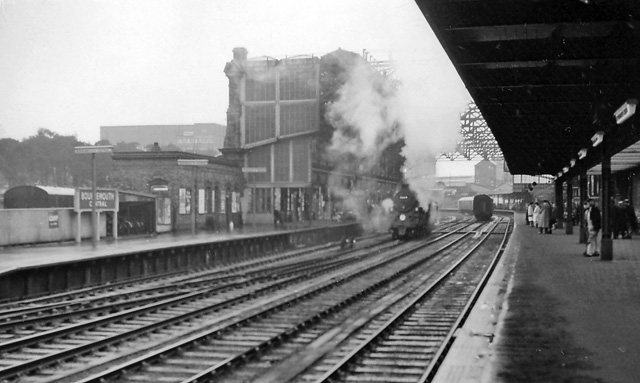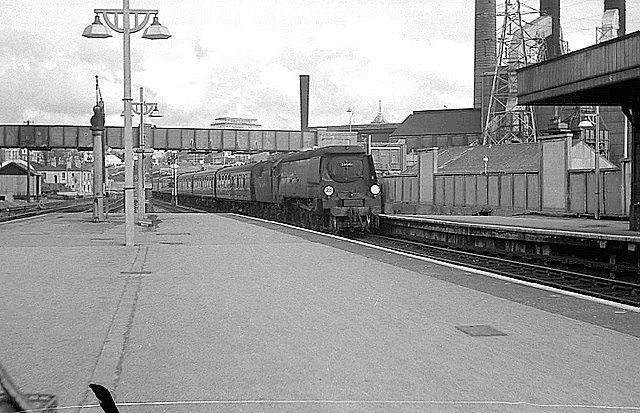|
Bournemouth West Railway Station
Bournemouth West railway station was a railway station in Bournemouth, Dorset, England. History The station opened on 15 June 1874. Although passenger trains were withdrawn from 6 September 1965 a substitute bus service was provided until official closure on 4 October 1965. The closure was originally temporary, but then became permanent and the station was demolished. The station was the southern terminus of the Somerset and Dorset Joint Railway, as well as being the terminus for trains from London Waterloo Waterloo station (), also known as London Waterloo, is a central London terminus on the National Rail network in the United Kingdom, in the Waterloo area of the London Borough of Lambeth. It is connected to a London Underground station of ... and other local trains. Accidents and incidents On 17 August 1956 a rake of carriages ran away colliding with another rake of carriages and a parcels van. The van was pushed into the parcels office bringing down its roof c ... [...More Info...] [...Related Items...] OR: [Wikipedia] [Google] [Baidu] |
Bournemouth West Station 1861607 F4776380
Bournemouth () is a coastal resort town in the Bournemouth, Christchurch and Poole council area of Dorset, England. At the 2011 census, the town had a population of 183,491, making it the largest town in Dorset. It is situated on the English south coast, equidistant () from Dorchester and Southampton. Bournemouth is part of the South East Dorset conurbation, which has a population of 465,000. Before it was founded in 1810 by Lewis Tregonwell, the area was a deserted heathland occasionally visited by fishermen and smugglers. Initially marketed as a health resort, the town received a boost when it appeared in Augustus Granville's 1841 book, ''The Spas of England''. Bournemouth's growth accelerated with the arrival of the railway, and it became a town in 1870. Part of the historic county of Hampshire, Bournemouth joined Dorset for administrative purposes following the reorganisation of local government in 1974. Through local government changes in 1997, the town began to be adm ... [...More Info...] [...Related Items...] OR: [Wikipedia] [Google] [Baidu] |
Bournemouth Central Railway Station
Bournemouth railway station is the main railway station serving the seaside town of Bournemouth, Dorset, England. It was previously known as Bournemouth East (1885 to 1899) and then Bournemouth Central (1899 to 1967). It has long been treated as an obligatory stop (major stop) on the South West Main Line from London Waterloo to Weymouth. It is down the main line from WaterlooRailways in the United Kingdom historically are measured in miles and chains. There are 80 chains to one mile. and is situated between and . A previous incarnation of Bournemouth East station was on another site. Ticket barriers were installed in 2008 and British Transport Police have a Bournemouth office at the station which acts as a regional hub. History The station was designed by William Jacob, chief engineer of the London and South Western Railway, and opened on 20 July 1885 as ''Bournemouth East'' replacing the original station of the same name on the other side of Holdenhurst Road from 1870 ... [...More Info...] [...Related Items...] OR: [Wikipedia] [Google] [Baidu] |
Former London And South Western Railway Stations
A former is an object, such as a template, gauge or cutting die, which is used to form something such as a boat's hull. Typically, a former gives shape to a structure that may have complex curvature. A former may become an integral part of the finished structure, as in an aircraft fuselage, or it may be removable, being using in the construction process and then discarded or re-used. Aircraft formers Formers are used in the construction of aircraft fuselage, of which a typical fuselage has a series from the nose to the empennage, typically perpendicular to the longitudinal axis of the aircraft. The primary purpose of formers is to establish the shape of the fuselage and reduce the column length of stringers to prevent instability. Formers are typically attached to longerons, which support the skin of the aircraft. The "former-and-longeron" technique (also called stations and stringers) was adopted from boat construction, and was typical of light aircraft built until the ad ... [...More Info...] [...Related Items...] OR: [Wikipedia] [Google] [Baidu] |
Southampton And Dorchester Railway
The Southampton and Dorchester Railway was an English railway company formed to join Southampton in Hampshire with Dorchester, Dorset, Dorchester in Dorset, with hopes of forming part of a route from London to Exeter. It received Parliamentary authority in 1845 and opened in 1847. It was promoted by Charles Castleman (Hampshire), Charles Castleman of Wimborne Minster, and became known as Castleman's Corkscrew because of the meandering route it followed. Its route across the New Forest was determined by the requirements of the Commissioners of Woods and Forests, Commissioners of the Forest, and west of Brockenhurst it ran via Ringwood, Hampshire, Ringwood; at that time Bournemouth was not considered an important settlement; Poole was served by a branch to Lower Hamworthy, across a toll bridge from the town. In the late 19th century, a shorter route via Christchurch, Dorset, Christchurch and Bournemouth was built, and the former main line between Lymington Junction and Hamworthy Ju ... [...More Info...] [...Related Items...] OR: [Wikipedia] [Google] [Baidu] |
Meyrick Park Halt
Meyrick Park Halt was a railway halt located in the Meyrick Park area of Bournemouth, just west of Bournemouth Central railway station in the county of Hampshire (now Dorset) in England. It opened in 1906 as a response to competition from street-running tramways, and served a growing suburb of Bournemouth as well as leisure activities. History In May 1905, the London and South Western Railway's (LSWR) board approved the expenditure of £167 on the construction of a halt comprising two short wooden platforms and huts in a cutting on the South West Main Line. Situated to the west of , the halt lay between the Central and West stations at a point halfway between Gasworks Junction and Central. It was connected to the lower end of Meyrick Park Crescent in Bournemouth by two flights of steps. The new station would serve the expanding suburb of Winton and Meyrick Park, an area of open space where an extensive golf links had been laid out. The decision to provide the halt followe ... [...More Info...] [...Related Items...] OR: [Wikipedia] [Google] [Baidu] |
Dorset Central Railway
Dorset ( ; archaically: Dorsetshire , ) is a county in South West England on the English Channel coast. The ceremonial county comprises the unitary authority areas of Bournemouth, Christchurch and Poole and Dorset. Covering an area of , Dorset borders Devon to the west, Somerset to the north-west, Wiltshire to the north-east, and Hampshire to the east. The county town is Dorchester, in the south. After the reorganisation of local government in 1974, the county border was extended eastward to incorporate the Hampshire towns of Bournemouth and Christchurch. Around half of the population lives in the South East Dorset conurbation, while the rest of the county is largely rural with a low population density. The county has a long history of human settlement stretching back to the Neolithic era. The Romans conquered Dorset's indigenous Celtic tribe, and during the Early Middle Ages, the Saxons settled the area and made Dorset a shire in the 7th century. The first recorded Viking ... [...More Info...] [...Related Items...] OR: [Wikipedia] [Google] [Baidu] |
Branksome Railway Station
Branksome railway station serves the Branksome and Branksome Park areas of Poole in Dorset, England. It is on the South West Main Line, down the line from . History The London and South Western Railway (LSWR) opened its line from Bournemouth to Poole in 1874, but the station was not opened until 1893. The S&DJR opened a locomotive depot at the station in 1895 which operated until closure of the line into Bournemouth West in 1965, after which the S&D trains ran, for the remaining few months of operation, into Bournemouth Central railway station, which had its own locomotive shed. The line between Bournemouth Central to Branksome and Bournemouth Traction and Rolling Stock Maintenance Depot Bournemouth Traction and Rolling Stock Maintenance Depot is a traction maintenance depot located in Bournemouth, South West England. The depot is situated on a spur off the South West Main Line and is to the east of Branksome station. The dep ... was electrified in 1967 to enable st ... [...More Info...] [...Related Items...] OR: [Wikipedia] [Google] [Baidu] |
British Rail Class 442
The British Rail Class 442 ( 5-WES) ''Wessex Electrics'' were electric multiple unit passenger trains introduced in 1988 by Network SouthEast on the South West Main Line from London Waterloo to Weymouth to coincide with the electrification of the line from Bournemouth. Twenty-four five-car units were built by British Rail Engineering Limited's Derby Litchurch Lane Works. Following the privatisation of British Rail, the fleet was sold to Angel Trains and operated by South West Trains up until February 2007, when they were replaced by Class 444 and Class 450s. After a period in storage, they were leased to Southern for use on Gatwick Express services from London Victoria to Gatwick Airport and Brighton. The units were withdrawn from Gatwick Express services in 2016 and from Southern peak-hour London Bridge to Brighton and Eastbourne services in March 2017. From 2019, eighteen were leased by South Western Railway for use on London Waterloo to Portsmouth Harbour services. Howeve ... [...More Info...] [...Related Items...] OR: [Wikipedia] [Google] [Baidu] |
London Waterloo Railway Station
Waterloo station (), also known as London Waterloo, is a central London terminus on the National Rail network in the United Kingdom, in the Waterloo area of the London Borough of Lambeth. It is connected to a London Underground station of the same name and is adjacent to Waterloo East station on the South Eastern Main Line. The station is the terminus of the South West Main Line to via Southampton, the West of England main line to Exeter via , the Portsmouth Direct line to which connects with ferry services to the Isle of Wight, and several commuter services around west and south-west London, Surrey, Hampshire and Berkshire. The station was opened in 1848 by the London and South Western Railway, and it replaced the earlier as it was closer to the West End. It was never designed to be a terminus, as the original intention was to continue the line towards the City of London, and consequently the station developed in a haphazard fashion, leading to difficulty finding the ... [...More Info...] [...Related Items...] OR: [Wikipedia] [Google] [Baidu] |
Bournemouth
Bournemouth () is a coastal resort town in the Bournemouth, Christchurch and Poole council area of Dorset, England. At the 2011 census, the town had a population of 183,491, making it the largest town in Dorset. It is situated on the Southern England, English south coast, equidistant () from Dorchester, Dorset, Dorchester and Southampton. Bournemouth is part of the South East Dorset conurbation, which has a population of 465,000. Before it was founded in 1810 by Lewis Tregonwell, the area was a deserted heathland occasionally visited by fishermen and smugglers. Initially marketed as a health resort, the town received a boost when it appeared in Augustus Granville's 1841 book, ''The Spas of England''. Bournemouth's growth accelerated with the arrival of the railway, and it became a town in 1870. Part of the Historic counties of England, historic county of Hampshire, Bournemouth joined Dorset for administrative purposes following the Local Government Act 1972, reorganisation of l ... [...More Info...] [...Related Items...] OR: [Wikipedia] [Google] [Baidu] |









